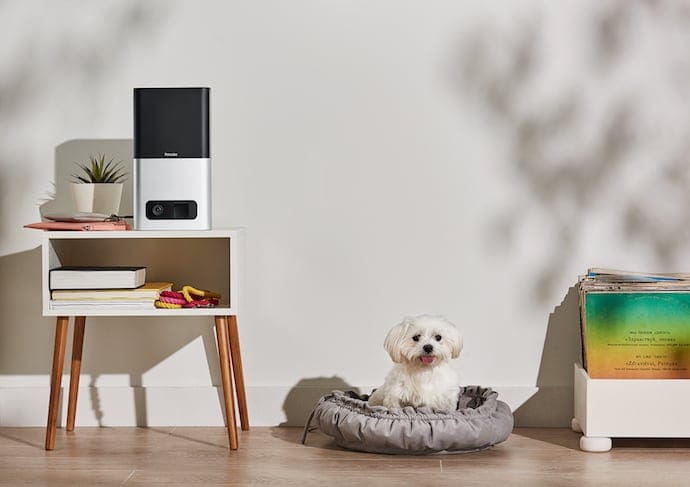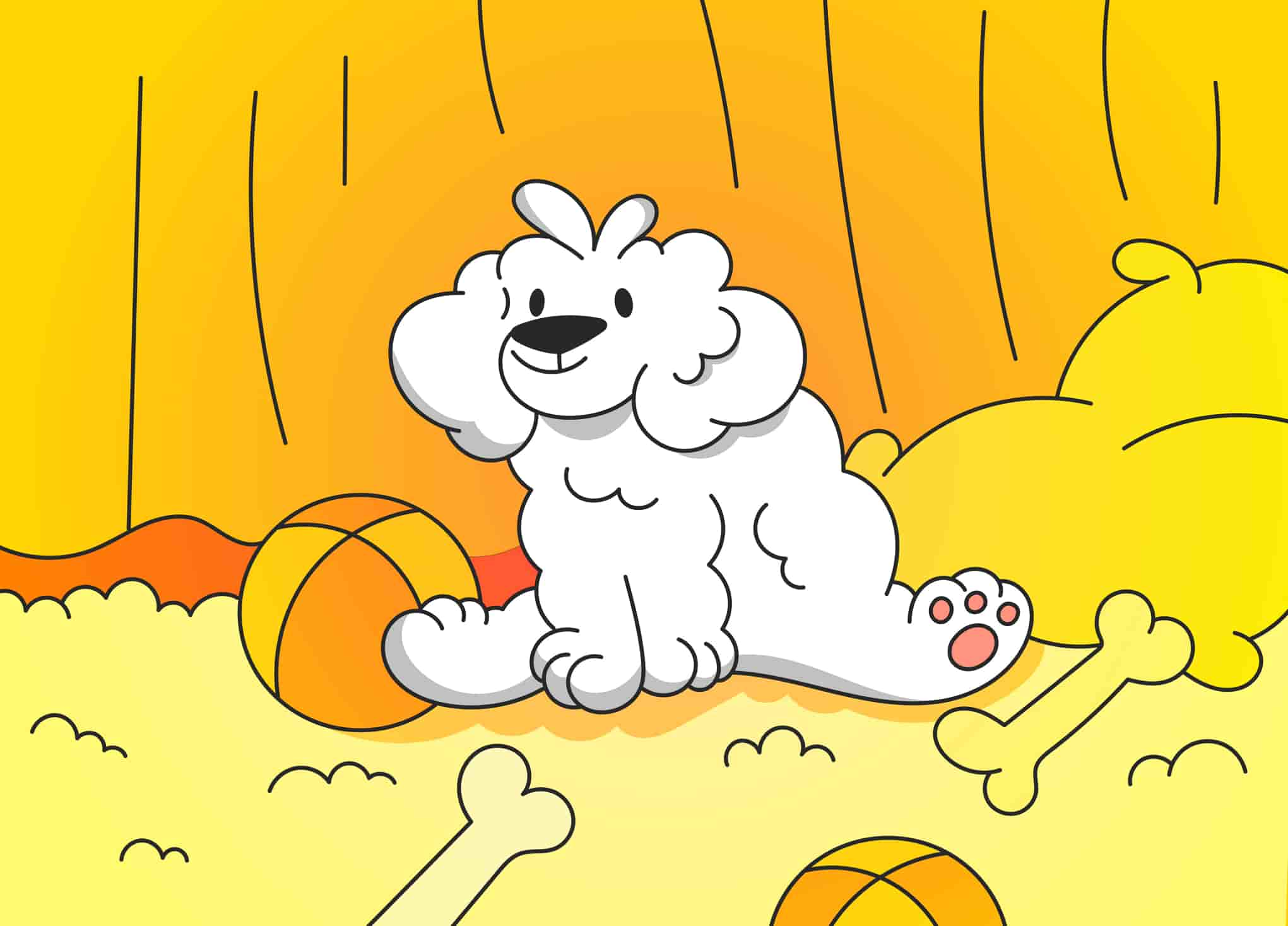Raising a puppy while working is tough, but it can be done.
Puppies have different needs depending on their age. After those intense first few weeks, things ease off. A combination of planning, friends, and paid help will certainly be a great support for you.
And the good news is, put the effort in early on and you’ll have a settled adult dog who copes just fine while you’re at work.
Stop Googling - Ask a Real Vet
Leaving a Puppy Alone While At Work
Working full-time means leaving a puppy home alone.
Oh, those puppy eyes! Leaving that adorable bundle of cuteness is hard, but is it fair?
Actually, yes it is. It’s a mistake for a puppy to be constantly in your company. This can make them over-dependent on people. This means they won’t learn the skill of being alone.
So leaving a puppy isn’t cruel but…how long can you leave a puppy home alone?
Read more: How Long Can You Leave A Dog Alone? Breeds, Tips, and Solutions
How long can puppies hold their pee? For this, there’s a simple equation.
- Take the puppy’s age in months and add one. This is the number of hours they can hold their bladder.
- For example, a two-month-old pup can hold for three hours max.
- A four-month-old pup can hold for five hours.
This equation levels out at around 6–7 months, with no dog being comfortable holding their pee above eight hours.
In practical terms, leaving a puppy home alone while at work, means you’ll need to give the pup comfort breaks at the appropriate times. Excluding comfort breaks mean risking the puppy getting confused about potty training, therefore, leading to an untrained dog.
Thus leaving a puppy alone for 8 hours isn’t great for any four-legger regardless of age (especially leaving a puppy alone at home for the first time!). While it’s technically possible for a young adult dog to hold on this long, a puppy needs frequent toilet breaks plus the stimulation of company.
This raises the question: What to do about the dog while at work?
The answer is to get help. Remember, this stage isn’t forever and these demanding times do pass.
Raising a Puppy While Working: Getting Help
Let’s say your bundle of fun is 8-weeks old. They need toilet breaks at least every three hours (for more options see the Toilet Training section.) Somehow they need walks outside for potty training and a game to amuse them.
This means planning ahead.
Your options include:
- Popping home in your breaks;
- Having a friend or neighbor called in;
- Employing a dog walker or puppy sitter to drop by;
- Leaving pup with a friend;
- Doggie daycare.
Let’s say your amazing neighbors are happy to help. And to plug the gap a dog walker calls in. But this still means leaving the puppy alone for some of the days. What about when you’re not there? How do you keep your puppy happy?
Keeping Your Puppy Happy
People have strong opinions about whether raising a puppy while working full time is fair to the dog. Moreover, raising a puppy in an apartment! Their main objection is that puppies need companionship and plenty of play. Of course, it fills you with sadness to think your pup might miss out, so what to do with a dog while at work?
Rule #1 is to leave the puppy pleasantly tired. This means plenty of play before heading out to work. Leave a puppy tired and they’ll snooze through their first comfort break. Problem one sorted!
Rule #2 is to give the puppy plenty to occupy them in-between visits. As well as the friend playing with the puppy, have a variety of toys and games pre-prepared for them to pop in with your pup when they leave.
Rule #3 is to think about your puppy's safety before you leave. Make their space safe from things that could harm or scare them. Hide the glass vase, put away cutting or piercing objects, and dog treats, so your child doesn't eat too much.
If you need even more reassurance that your dog is safe and that you can leave them alone, there is a solution. Subscribing to the Pet Emergency Fund for less than $1/day will give you access to a certified veterinarian’s support 24/7 and guarantee you that your bills will be covered in case of an emergency. So you can be prepared if something happens to your four-legged friend in your absence.
Great tricks to try
- Use Puzzle Feeders: Have the sitter leave the pup’s next meal in a puzzle feeder, such as a Kong. That way your pup takes time to eat, doesn’t notice the sitter has left, and settles down for a snooze.
- Freeze the Puzzle Feeder: In warm weather, freeze the food-filled Kong. It will take the puppy hours to lick out their meal. This provides great mental stimulation to prevent boredom from setting in.
- Safe Chew Toys: Make sure the toy is sturdy enough to be left with a teething puppy. Smear the toy with peanut butter, to make it extra tasty.
The Cardboard Box Trick: Seal a treat inside a cardboard box. Let the puppy chew through to the treat. - Rolled-up Newspaper: Put a few pieces of kibble or a treat inside a rolled-up newspaper. Add tape around it to stop the treats from falling out and offer it as a chew toy.
You get the idea!
Monitor Your Pup Using a Petcube Pet Camera

You might wonder "Is raising a puppy hard?". No one said that doing it while working was easy! It hurts to be away from your pup. But there are ways that can ease your mind AND enrich the puppy’s day.
Petcube is more than a pet camera (although this is important.) While at your desk, Petcube shows what your furry friend is up to right there and then. From laughing at their antics to being reassured that they’re snoozing, Petcube eases your natural concern.
More than this, you can speak to your pup through Petcube. Establish good behaviors, even from a distance. With Petcube dog camera you can praise them for resting peacefully and get them into good habits.
Plus, they can play ‘hunt the red dot’ and fling treats as a reward. As virtual pet sitting goes, Petcube spells furry fun for your pet pal.
Preventing Separation Anxiety
If the puppy links your disappearance with long hours of tedium, they may cry for you to return. This can become a learned behavior, where the dog cries when left alone.
Preventing this means leaving boredom busters for the pup to play with (see above). But it also involves leaving home in the ‘right’ way, without making a fuss. And you can always discuss tips for raising a puppy with a vet online!
Read more: Separation Anxiety In Dogs: The Definitive Guide
What NOT to Do
You’re going to miss your fuzz-ball like crazy. So when you leave, you make a big fuss, give lots of cuddles, bury your face in their fur, and apologize for going. Heck, you may even shed a tear or two.
But what message does this send to the pup?
Puppies quickly pick up that you don’t want to go. And the next thing that pops into a puppy’s mind is that their pet parent going is a bad thing. Puppy cries when left alone. You soothe their crying, hence rewarding their anxiety.
This is a pattern of action and reward which ends with the dog always acting up when you leave.
What To Do
Even though your heart is breaking, don’t make a big thing of parting. In fact, sneak out.
Play with the pup ahead of leaving. Then settle them down with a chew stick. When your pup’s otherwise distracted, quietly go.
No big ‘Goodbye’, just slide out the door (and then monitor via Petcube to see how well they have settled).
Also, shake up your leaving routine. Change the order in which you put on your coat and pick up the car keys. Go out through different doors. When there are no clear clues you’re about to go, the puppy worries less.
Read more: How to Discipline a Puppy Without Punishment
How to Potty Train a Stubborn Puppy
It is scientifically proven that the biggest hurdle is potty training. When you’re home, you’re able to walk your puppy outside every half an hour. But this isn’t possible when raising a puppy while you work full time. So how to potty train a puppy when you work?
You have two options:
- The Puppy Pen: With a bed area and a separate toilet spot;
- Crate Train: With appropriately timed comfort breaks.
The Puppy Pen Method
A puppy that regularly soils themselves will stop trying to hold on. Down this path lies the dog that is not house trained.
If you can’t rely on people popping in, then use the puppy pen method.
The solution is to keep your puppy safe within a playpen, but in an area that’s large enough to hold their bed, toys, and a corner for puppy pads.
Encourage and praise the puppy to use the pads as a toilet. Then when left alone, when given a choice of soiling their bed or the pads, they’ll head for the pads (and you reinforce this behavior with praise via your Petcube!).
Read more: How to Potty Train a Puppy: Your Guide to Success
Crate Training
Done well, crate training gives the puppy a den or a fun place for them to call home.
Done badly, a crate is a prison and a place that a puppy will hate spending time in.
How to potty train a puppy with a crate?
1. Get the Set Up Right
Choose a crate that’s big enough for a puppy to stand up in and lie down with their legs outstretched. If necessary, buy a larger crate but use a partition to get the size right. Give a pup too much room and they won’t learn to hold their bladder.
Place the crate in a quiet corner, but in a room where they can see what’s going on. Then make the crate super comfy with a soft bed and some toys.
2. Good Things Happen in the Crate
Hide treats in the crate and let the puppy find them.
Put great toys in the crate.
Feed the puppy in the crate (with the door open).
The idea is that the puppy will begin to link the crate to good things.
Only once they’re popping in on their own accord, can you close the door briefly, praise your pup, and then open the door.
3. Reward Calm Behavior
Feed your puppy in the crate and briefly close the door. Praise their calm behavior and then open the door.
Gradually extend the length of time the door is closed.
Be sure to tell your pup how clever they are for remaining calm.
And here’s the thing… only open the door when they are calm and quiet. This rewards their good behavior, rather than crying.
4. Leave the Room
With your puppy in the closed crate, leave the room for a few seconds.
Only return when they are quiet and then let them out and give lots of praise.
Remember, returning or letting a puppy out when they’re crying, rewards bad behavior and tells them that crying gets them what they want. Don’t go there!
Well done! You now have a crate-trained puppy.
Crate training a puppy while at work is great for many reasons:
- Your puppy is kept safely away from objects they may chew or swallow;
- They feel safe in their den;
- It promotes good bladder and bowel control.
Speaking of bladder control…
How to Potty Train a Puppy When You Work
Before you start, put two things in place. First, crate train your puppy, and second, arrange for regular toilet breaks at appropriate intervals.
Before leaving for work, play with your pup and take them out for a potty break. When they go, give the usual praise and reward. Then pop your pup into the crate with a safe chew toy.
Make a low-key departure for work. Check that they are OK via Petcube.
Have a friend pop in to give them a comfort break. For a 10-week-old puppy, make sure this is at least every 3 hours. Take your pup to the potty training spot (by this time they should be busting), and praise and reward when they go.
Play with your pup and then settle them back down into the crate.
Repeat this throughout the day until you return home from work.
5 Puppy House Training Tactics
Don’t expect too much too soon from your puppy. Few puppies have any bladder control before 8 weeks of age (and this basically answers the question "can I leave my 8 week old puppy home alone?"), which is when training starts.
Some pups learn faster than others, so be patient. If you’re lucky, some pick it up within 2–4 weeks, but others take much longer. When you’re home, speed up toilet training with Petcube’s top training tactics:
1. Set Up for Success
Recognize when a puppy is most likely to pee. This is after a nap, a few minutes after eating, and if they haven’t urinated in the past half hour. Take the pup to the toilet spot at these times and the chances are they’ll perform.
2. Praise, Praise, and More Praise
When a puppy realizes they get a reward simply for relieving themselves, they’ll start to save up their pee in order to ‘spend’ it for a treat.
3. Stay with Puppy
Don’t put your pup in the garden and leave them alone. A puppy is easily distracted and will probably play with a leaf rather than concentrate on the job. Make sure they are focused by staying with the pup and only letting them play AFTER they go.
4. Never Punish a Puppy
When a puppy has an accident in the wrong place, never smack or rub their face in it. This makes toilet training harder, not easier, as a puppy learns you have an irrational dislike of their bodily function.
5. Clean Accidents Effectively
Clean up spills with a good deodorizing cleaner. This removes scent markers that might draw the puppy back to the same spot.
Read more: Puppy Care 101: A Guide for the First Time Puppy Owner
24/7 Puppy Care
Raising a puppy when you work full time is tough, but you will find a way.
Plan ahead, ask for help, and use Petcube to raise a puppy through those demanding early days. The reward is a well-adjusted adult dog with a wagging tail to welcome you home at the end of a long day.
Plus, you can always have a peace of mind for your pup in case of a critical medical emergency. Petcube has got you covered for that as well. Woofs to happy puppies!

Was this article helpful?
Help us make our articles even better









